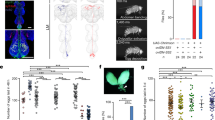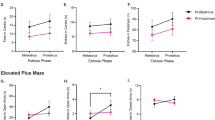Abstract
There is controversy surrounding the issue of whether there is menstrual synchrony in women who live together1,2,3,4, particularly in the case of the coupled-oscillator model developed5 to explain similar data from rats. Stern and McClintock6 have proposed that the rat model applies to women, with the effect being mediated by two opposing axillary ‘pheromones’ that could affect major reproductive events and have potential for “either contraception or treatment of infertility”.
Similar content being viewed by others
Main
This claim6 is based on data derived from four cycles from each of 20 subjects treated with axillary compounds to change the cycle length from that of each subject's baseline cycle. Subjects' upper lips were wiped daily with pads worn in the axillae of donors in follicular or ovulatory phases of their cycles. The cycles of subjects wiped with follicular pads appeared to be shortened by 1–14 days, whereas cycles of those wiped with ovulatory pads were longer by 1–12 days. One-third of cycles did not change or changed in the opposite direction.
My main criticism of the study is the use of the value of the single first cycles, receiving carrier-only treatment, to derive the data analysed. Such single observations have no within-subject variance and the irregular statistical manoeuvre of converting all 20 observations to zero masks any between-subject variance and provides an illusory zero baseline with indeterminate confidence limits. Carrier-only treatments should have been distributed throughout this long experiment to give a balanced crossover design with three treatments (carrier, follicular and ovulatory) and two or more complete replications to confer confidence limits to the baseline observations, thus making comparisons valid.
Each group has an apparent outlier favourable to the model: one of −14 comprises 25% of the total shortening, whereas that of +12 makes up 22% of the increase. Excluding these two outliers would abolish the claim of significance.
Reference to the first cycle throughout the long experiment may have introduced biases because of environmental, physiological and social drifts. McClintock1 reported that women “who estimated seeing males less than three times per week” had cycles 1.5 days shorter than those who spent more time with males. Others claim that cycles are affected by sexual activity or the phase of the moon7,8.
I am not convinced of the validity of the coupled-oscillator model derived from rat studies5. I also question the “definitive evidence” that pheromones regulate human ovarian function because, if these exist, their characterization will require large, carefully designed experiments, a controlled social and physical environment, and a clearly defined endpoint measured in hours.
References
McClintock, M. K. Nature 291, 244–245 (1971).
Trevathan, W. R., Burleson, M. H. & Gregory, W. L. Psychoneuroendocrinology 18, 425–435 (1993).
Wilson, H. C. Psychoneuroendocrinology 17, 565–591 (1992).
Strassmann, B. I. Curr. Anthropol. 38, 123–129 (1997).
Schank, J. & McClintock, M. K. J. Theor. Biol. 157, 317–362 (1992).
Stern, K. & McClintock, M. K. Nature 392, 177–179 (1998).
Cutler, W. B., Garcia, C. R. & Kreiger, A. R. Psychoneuroendocrinology 4, 297–309 (1979).
Cutler, W. B. Am. J. Obstet. Gynecol. 137, 834–839 (1980).
Author information
Authors and Affiliations
Corresponding author
Rights and permissions
About this article
Cite this article
Whitten, W. Pheromones and regulation of ovulation. Nature 401, 232 (1999). https://doi.org/10.1038/45720
Issue Date:
DOI: https://doi.org/10.1038/45720
This article is cited by
-
Women do not synchronize their menstrual cycles
Human Nature (2006)
Comments
By submitting a comment you agree to abide by our Terms and Community Guidelines. If you find something abusive or that does not comply with our terms or guidelines please flag it as inappropriate.



